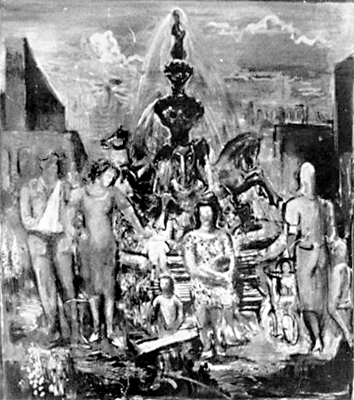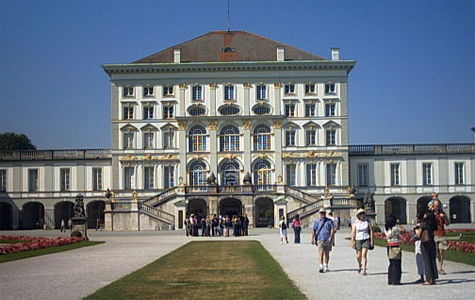|
(dma) -
Christian Hess‘ wide-ranging artistic production also
included designs for fashion, clothing in general, textiles and furnishings.
Many of his paintings and sketches - not to mention his designs for theatrical
costumes and masks which may be seen in the section entiled „Scenography“ -
were by no means limited to reflecting fashionable trends of the 1920‘s and
1930‘s but actually sought to create new tendencies.
It is no coincidence
that in those years Hess was working for the
silk factories in Krefeld for whom he
produced textile designs on a monthly
retainer of 300 marks. It is likely that
Hess‘ paintings did not simply reproduce the
fashion designs currently in vogue in the
fashion houses but rather sought to propose
more audacious and groundbreaking
inventions: more plunging necklines for the
classice pearl grey and dark grey silk
dresses, more vivacious colours for the
bathing costumes and the rest of the summer
collections and for the rest of the fashion
year with colourful designs for foulards,
stoles and hats.
In practice Hess‘ „designer“ paintings were
part of and contributed to the development
of women‘s fashion of the time, which from
the 1920‘s rapidly became less severe: less
concerned with straitlaced modesty and
covering up and more interested in
uncovering and freedom. Hess‘ passion for
fashion may be guaged by the fact that when
he travelled he frequently took with him his
small 1931 painting „Model with foulard“,
which he considered a kind of lucky charm.
|
Like a poster, but 70 years earlier |
 |
|
Couple in bathing costumes
(Messina 1930) Oil on canvas 100
x 80 cm
|
One of Hess‘ paintings could be said to have
been at least 70 years ahead of its time,
seeming nothing less than an early version
of a late 20th century
advertising hoarding for United Colours of
Benetton. The painting „Couple in bathing
costumes“, which Hess produced in the summer
of 1930 in Messina, shows a young
dark-skinned Sicilian man holding hands with
a blonde woman of pale rosy complexion. Both
are wearing brightly coloured bathing
costumes – outfits that would have been
considered rather bold at the time. Similar
themes, although obviously with more modern
treatment, were common elements in the late
20th century advertising
campaigns on hoardings, photo murals and
posters used to great effect by the Italian
clothing giant Benetton. The same
straight-on poses – multi-racial humanity
purified not least by its own clothes – were
used by the Italian photographer Oliviero
Toscani for his Benetton campaigns. The 1930
painting and the 1990‘s posters recall the
photographic style of the „identifying
objectivity“ of the German school which,
however, supercedes national boundaries.
|
|
A Tapestry for the Nymphenburg Palace in
1941 |
|

In
1941 Hess completed the draft
for a tapestry to be hung in the
Nymphenburg Palace in Munich.
 On
the reverse side of a photo of
the preliminary sketch
(unfortunately in black and
white) Hess noted the finished
tapestry would measure five
metres by four. The design
reflects the sombre melancholy
that reigned in the Nymphenburg
Gardens during World War Two, in
stark contrast to the relaxed
and pleasurable atmosphere of
peacetime, when residents of the
Bavarian capital would meet and
stroll. Hess‘ drawing shows
women and children gathered
around the fountain with its
prancing horses beneath a livid
sky. The only male figure is an
injured soldier with his arm in
a sling who is with a young
woman. We must imagine that the
young couple are meeting at the
Nymphenburg after a long absence
for the soldier who, wounded in
action, is now enjoying a brief
spell of leave for
convalescence. On
the reverse side of a photo of
the preliminary sketch
(unfortunately in black and
white) Hess noted the finished
tapestry would measure five
metres by four. The design
reflects the sombre melancholy
that reigned in the Nymphenburg
Gardens during World War Two, in
stark contrast to the relaxed
and pleasurable atmosphere of
peacetime, when residents of the
Bavarian capital would meet and
stroll. Hess‘ drawing shows
women and children gathered
around the fountain with its
prancing horses beneath a livid
sky. The only male figure is an
injured soldier with his arm in
a sling who is with a young
woman. We must imagine that the
young couple are meeting at the
Nymphenburg after a long absence
for the soldier who, wounded in
action, is now enjoying a brief
spell of leave for
convalescence.
|
|